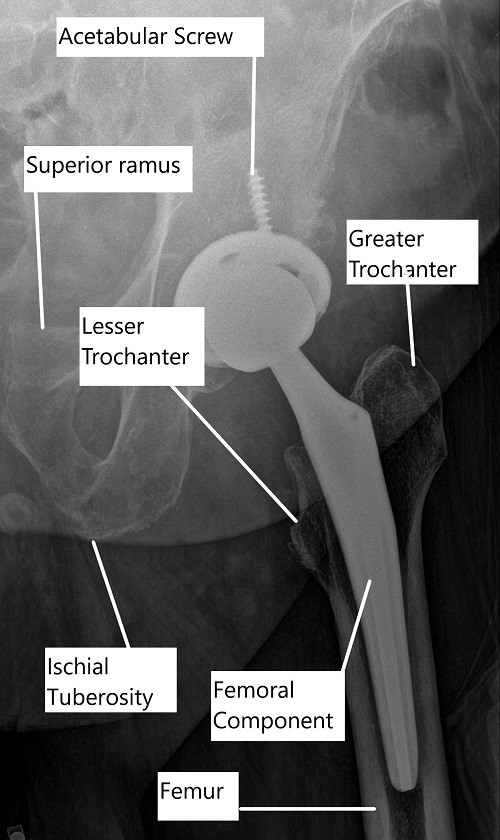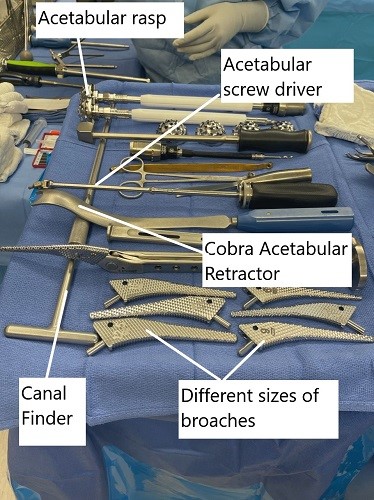Outpatient Hip Replacement
Outpatient hip replacement surgery allows patients to return home the same day after their procedure, thanks to advancements in surgical techniques, anesthesia, and pain management. This option is available for medically healthy patients who meet specific criteria, offering the same benefits as traditional hip replacement surgery with the added advantages of a quicker recovery and reduced hospital stay.
How Common It Is and Who Gets It? (Epidemiology)
Outpatient hip replacement is typically recommended for patients with hip arthritis who have not responded to conservative treatments like medications and physical therapy. Ideal candidates are generally younger (under 70 years of age), non-smokers, and free of significant comorbidities like diabetes, cardiovascular disease, or lung disease.
Why It Happens – Causes (Etiology and Pathophysiology)
Hip replacement surgery is often performed due to osteoarthritis or rheumatoid arthritis, conditions that cause the degradation of the cartilage in the hip joint, resulting in pain and limited movement. Other causes can include trauma, developmental disorders like hip dysplasia, or diseases that impair the hip joint’s function.

X-ray showing a total hip replacement.
How the Body Part Normally Works? (Relevant Anatomy)
The hip joint is a ball-and-socket joint, with the femoral head (ball) fitting into the acetabulum (socket) of the pelvis. The surfaces are covered with smooth cartilage that allows frictionless movement. When the cartilage wears away, it causes pain and stiffness, leading to the need for hip replacement.
What You Might Feel – Symptoms (Clinical Presentation)
-
Pain: Persistent pain in the hip, especially with weight-bearing activities.
-
Stiffness: Difficulty moving the hip in all directions.
-
Difficulty Walking: Limping or trouble standing or sitting for prolonged periods.
How Doctors Find the Problem? (Diagnosis and Imaging)
-
X-rays: To examine joint space narrowing and signs of arthritis.
-
MRI or CT scan: Used for detailed imaging of bone and soft tissue structures.
-
Physical Exam: To assess range of motion, pain, and hip function.
Procedure Types or Techniques (Classification)
-
Traditional Hip Replacement: Involves a larger incision and more muscle disruption.
-
Minimally Invasive Hip Replacement: A smaller incision with less muscle disruption.
-
Outpatient Hip Replacement: Performed using minimally invasive techniques, allowing for same-day discharge.
Other Problems That Can Feel Similar (Differential Diagnosis)
-
Trochanteric bursitis: Inflammation of the bursa near the hip joint.
-
Sciatica: Nerve pain radiating down the leg.
-
Labral tears: Damage to the cartilage in the hip joint that can mimic arthritis symptoms.
Treatment Options
-
Non-surgical: Medications, physical therapy, and lifestyle changes.
-
Surgical: Hip replacement surgery (either outpatient or traditional).
Recovery and What to Expect After Surgery
-
Immediate Recovery: Most patients are able to walk with crutches or a walker shortly after surgery and may return home the same day.
-
Physical Therapy: Begins the same day to help restore movement and strength.
-
Full Recovery: Usually takes 6-12 weeks, with most patients returning to daily activities in a few weeks.
Possible Risks or Side Effects (Complications)
-
Infection: A risk with any surgery.
-
Blood clots: Can form in the legs (deep vein thrombosis).
-
Dislocation: The new hip can potentially dislocate during recovery.
-
Leg length discrepancy: A slight difference in leg length may occur after surgery.
Long-Term Outlook (Prognosis)
-
Pain Relief: Most patients experience significant pain relief.
-
Functional Improvement: Most patients regain full or near-full functionality.
-
Implant Longevity: Implants typically last 15-20 years, depending on the patient’s activity level.

Instruments used in a total hip replacement.
Out-of-Pocket Cost
Frequently Asked Questions (FAQ)
Q. How long is the hospital stay?
A. Typically, patients go home the same day or the next day.
Q. When can I return to work?
A. Sedentary jobs: 2-4 weeks; physically demanding jobs: 6-8 weeks.
Q. What activities can I do after surgery?
A. Low-impact activities like walking, swimming, and cycling. High-impact activities should be avoided.
Summary and Takeaway
Outpatient hip replacement offers a faster recovery and a more convenient recovery environment at home. It’s a good option for patients who meet the criteria, and it can lead to a smoother recovery compared to traditional inpatient surgery. However, patients must follow all postoperative instructions carefully to avoid complications.
Who Performs This Surgery? (Specialists and Team Involved)
Orthopedic surgeons specializing in hip replacement surgery perform the procedure, assisted by anesthesiologists and a surgical team.
When to See a Specialist?
If you have persistent hip pain that interferes with daily activities and have not found relief from non-surgical treatments, it’s time to consult an orthopedic surgeon to discuss surgical options.
When to Go to the Emergency Room?
Seek immediate care if you experience severe pain, infection signs (fever, swelling, redness), or if the hip dislocates.
What Recovery Really Looks Like?
Recovery involves managing pain, following a physical therapy plan, and gradually returning to daily activities. Most patients regain significant function within 6-12 weeks, with minimal restrictions.
What Happens If You Delay Surgery?
Delaying surgery may lead to further joint deterioration, increased pain, and potentially more complex surgery.
How to Prevent Recurrence or Failure?
Maintain a healthy weight, avoid high-impact activities, and follow the rehabilitation plan to ensure the longevity of the hip implant.
Nutrition and Bone or Joint Health
Ensure adequate intake of calcium and vitamin D to support bone health. Avoid smoking and limit alcohol to aid healing and implant longevity.
Activity and Lifestyle Modifications
Engage in low-impact activities, avoid high-impact exercises, and follow your surgeon’s recommendations for long-term care and mobility.
Do you have more questions?
What are the criteria for being considered a candidate for outpatient hip replacement surgery?
Candidates for outpatient hip replacement surgery typically include patients who are in good overall health, have a strong support system at home, and are motivated to actively participate in their recovery.
How is outpatient hip replacement surgery different from traditional inpatient surgery?
Outpatient hip replacement surgery involves a shorter hospital stay or no hospitalization at all, with patients being discharged on the same day as the surgery. Traditional inpatient surgery requires an overnight stay or longer hospitalization.
What are the potential benefits of outpatient hip replacement surgery?
Potential benefits include reduced hospitalization costs, faster recovery, decreased risk of hospital-acquired infections, and the ability to return to the comfort of home sooner after surgery.
How is pain managed during and after outpatient hip replacement surgery?
Pain management techniques may include a combination of regional anesthesia, nerve blocks, oral medications, and non-pharmacological interventions to ensure patient comfort during and after surgery.
Are there any specific pre-operative preparations required for outpatient hip replacement surgery?
Pre-operative preparations may include medical evaluations, imaging tests, cessation of certain medications, and lifestyle modifications to optimize surgical outcomes and minimize risks.
What is the typical timeline for recovery and rehabilitation after outpatient hip replacement surgery?
Recovery and rehabilitation timelines can vary depending on individual factors, but many patients are able to resume normal activities within a few weeks to months after surgery, with the guidance of a physical therapist.
How is infection risk minimized during outpatient hip replacement surgery?
Strict adherence to sterile techniques, antibiotic prophylaxis, and other infection prevention protocols are utilized to minimize the risk of surgical site infections during outpatient hip replacement surgery.
Can patients with underlying medical conditions undergo outpatient hip replacement surgery?
Patients with certain well-controlled medical conditions may still be candidates for outpatient hip replacement surgery, but individual assessment and consultation with a healthcare provider are necessary to determine suitability.
What type of anesthesia is typically used for outpatient hip replacement surgery?
Patients may receive either general anesthesia or regional anesthesia, depending on their medical history and the preference of the surgical team.
Are there any age restrictions for patients undergoing outpatient hip replacement surgery?
Age alone is not a determining factor for candidacy, as suitability for surgery depends on overall health and individual circumstances.
How soon after surgery can patients expect to be discharged home following outpatient hip replacement surgery?
Patients are typically discharged home on the same day as surgery, once they have met specific criteria for readiness, such as stable vital signs, pain control, and ability to safely mobilize.
What follow-up care is necessary after outpatient hip replacement surgery?
Follow-up care typically involves regular post-operative appointments with the surgeon to monitor healing, address any concerns, and track progress. Physical therapy may also be recommended to aid in recovery.
Are there any dietary restrictions or nutritional guidelines that patients should follow before or after outpatient hip replacement surgery?
While there are no specific dietary restrictions, maintaining a balanced diet rich in nutrients can support the healing process and overall recovery.
How soon can patients expect to experience pain relief and improved mobility after outpatient hip replacement surgery?
Many patients experience significant pain relief and improved mobility shortly after surgery, with continued improvement over the following weeks and months as they engage in rehabilitation exercises.
Can outpatient hip replacement surgery be performed using minimally invasive techniques?
Yes, outpatient hip replacement surgery can often be performed using minimally invasive techniques, which involve smaller incisions and less disruption to surrounding tissues, potentially leading to faster recovery and less post-operative pain.
What factors determine whether a patient is a suitable candidate for outpatient hip replacement surgery?
Factors such as overall health, medical history, age, and the presence of a strong support system at home are considered when determining candidacy for outpatient hip replacement surgery
How is the accuracy of implant placement ensured during outpatient hip replacement surgery?
Advanced imaging techniques and robotic-assisted technology may be used to ensure precise implant placement and optimal alignment of the hip joint during outpatient hip replacement surgery.
What are the potential risks and complications associated with outpatient hip replacement surgery?
While complications are rare, they can include infection, blood clots, implant loosening, nerve injury, or fracture. Your surgeon will discuss these risks and how they are minimized during the procedure.
Can outpatient hip replacement surgery be performed on both hips simultaneously?
Simultaneous bilateral hip replacement surgery may be considered for select patients, but individual assessment and consultation with a healthcare provider are necessary to determine suitability and minimize risks.
How is blood loss managed during outpatient hip replacement surgery?
Blood loss during surgery is minimized through meticulous surgical techniques, the use of minimally invasive approaches, and the administration of medications to promote clotting.
Are there any restrictions on driving or returning to work after outpatient hip replacement surgery?
Patients may be advised to refrain from driving for a certain period of time and to gradually return to work or other activities as guided by their surgeon and physical therapist.
Can patients with a history of previous hip surgeries undergo outpatient hip replacement surgery?
Patients with a history of previous hip surgeries may still be candidates for outpatient hip replacement surgery, but individual assessment and consultation with a healthcare provider are necessary to determine suitability.
How is post-operative pain managed for patients undergoing outpatient hip replacement surgery?
Pain management techniques may include a combination of oral medications, regional anesthesia, nerve blocks, or other modalities to ensure patient comfort during recovery.
What type of rehabilitation exercises are recommended after outpatient hip replacement surgery?

Dr. Mo Athar
[et_pb_button admin_label="Button" button_url="https://stage.cortho.org/general-appointment/" url_new_window="off" button_text="Schedule an Appointment" button_alignment="center" background_layout="light" custom_button="on" button_text_color="#FFFFFF" button_bg_color="#02770B" button_border_color="#FFFFFF" button_letter_spacing="1" button_font="Arial" button_on_hover="on" button_text_color_hover="#FFFFFF" button_bg_color_hover="#02770B" button_letter_spacing_hover="1" /]
